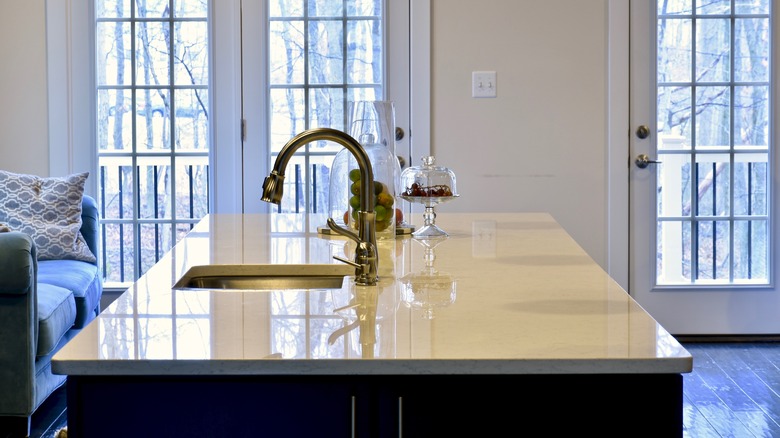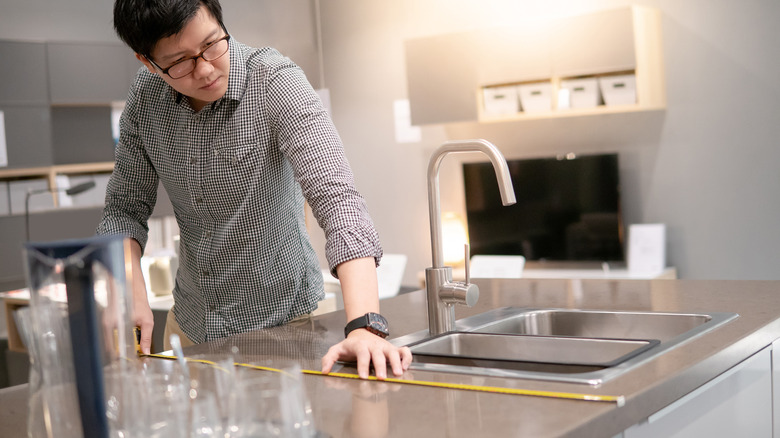Tips To Achieve A High-End Kitchen With Laminate Countertops
When it's time for a big kitchen renovation, countertops are a natural place to start. They take up a ton of visual space, and you use them multiple times every day. Marble, quartz, and even butcher's block come up as the usual suspects, but have you given laminate a fair shot? Laminate countertops offer a range of advantages that make them a popular and practical choice for kitchen surfaces. They're cost-effective, available in a ton of colors, patterns, and finishes, are easy to clean, and installation is relatively straightforward. With advancements in design, modern laminate closely mimics the aesthetic appeal of more expensive materials, offering an attractive and practical solution for stylish kitchen designs.
But even with all of these advantages, laminate countertops have gotten a bad reputation in the world of home design — many of us remember the flimsy countertops in our grandparents' homes, complete with unsightly black, non-continuous edges and dings. So, how do you use this affordable but underrated material in your home without harkening back to the dreadful designs of the last century? You need to keep three major key points in mind: the quality of the base materials, how they will tie in with your home design, and how to install them to get the best finish possible.
Selecting the right vinyl piece is key
While you're choosing a more affordable countertop material than, say, solid marble, quartz, or granite, you don't want to go for the cheapest variety and call it a day. To avoid the laminate from looking low-quality, you want to find material that is fairly thick, much thicker than basic contact paper or peel-and-stick wallpaper. Keep in mind you'll be wrapping your existing countertops in the laminate, so there won't be an exact conversion for regular countertops — however, most manufacturers produce laminate worktops in 22, 28, and 38-millimeter depths. Not only does the thickness help mimic natural stone and wood countertops, but it also makes them even sturdier and less resistant to noticeable dents, preserving your laminate countertops for longer.
Beyond the functional choices, you also want to keep your home's overall design in mind and what style you're decorating the kitchen in. If you want a super rustic kitchen, it won't make sense to go for an ultra-modern geometric tile pattern. Instead, look for a laminate worktop with natural wood grain textures, like this Rustic Wood Laminate from Worktop Express. You should also consider your kitchen's appliance and plumbing finishes, paint color, and any backsplashes you plan to keep or install during the kitchen renovation. Remember, there is a wide variety of colors, patterns, and even textures available for laminate countertops now, so this material really can work for any home design aesthetic.
Proper installation makes the biggest difference
The golden rule, when it comes to any project, is "measure twice, cut once," and that applies to properly installing laminate countertops as well. Especially if you're installing the laminate coating yourself, you want to make sure you've accounted for everything like beveled edges, under-mounted sink edges, electrical outlets, and so on in your measurements, and make sure you have a game plan when it comes to getting the laminate flush with these obstructions. Previously, laminate installation on corners left a little gap where it couldn't be folded over, but that isn't the case anymore as long as you use a high-quality laminate — another reason to spend a little more when choosing your materials.
Be sure to do your research before the installation day — so it's as easy and stress-free as possible. However, even all the research in the world won't help if you're lacking DIY skills, time, or patience. In that case, it really is best to call a professional to help with installation, especially if your countertops have intricate or non-standard right-angle edges. Whether laminate is properly measured, applied, and sealed can make all the difference between it looking cheap or high-end. Finally, while laminate can be sturdy and durable when installed properly, it can cause lots of issues if not, particularly if you have any gaps in the edges, which can be vulnerable to leaks and water damage. Make sure each seam is sealed but without visible adhesive appearing.


